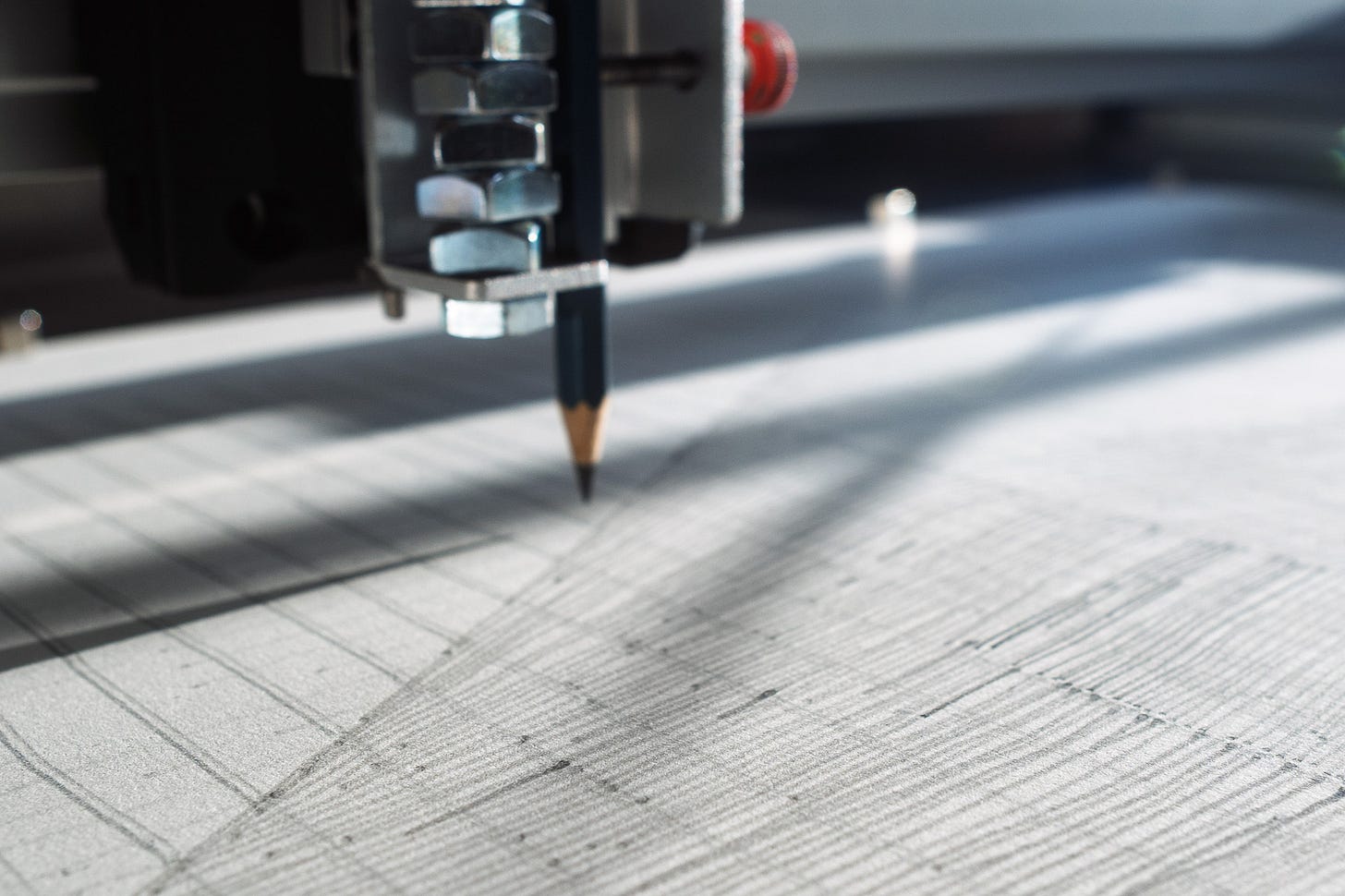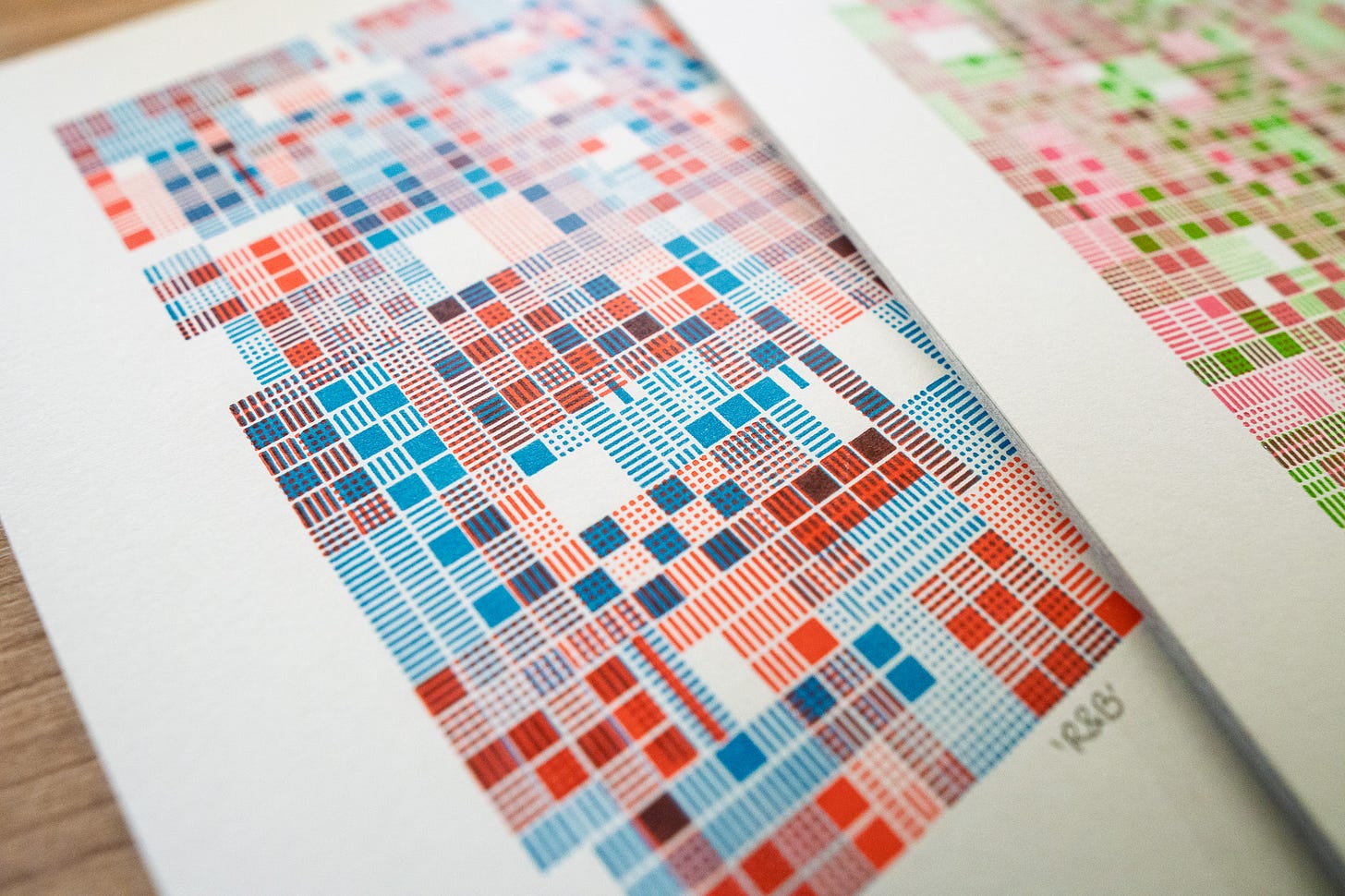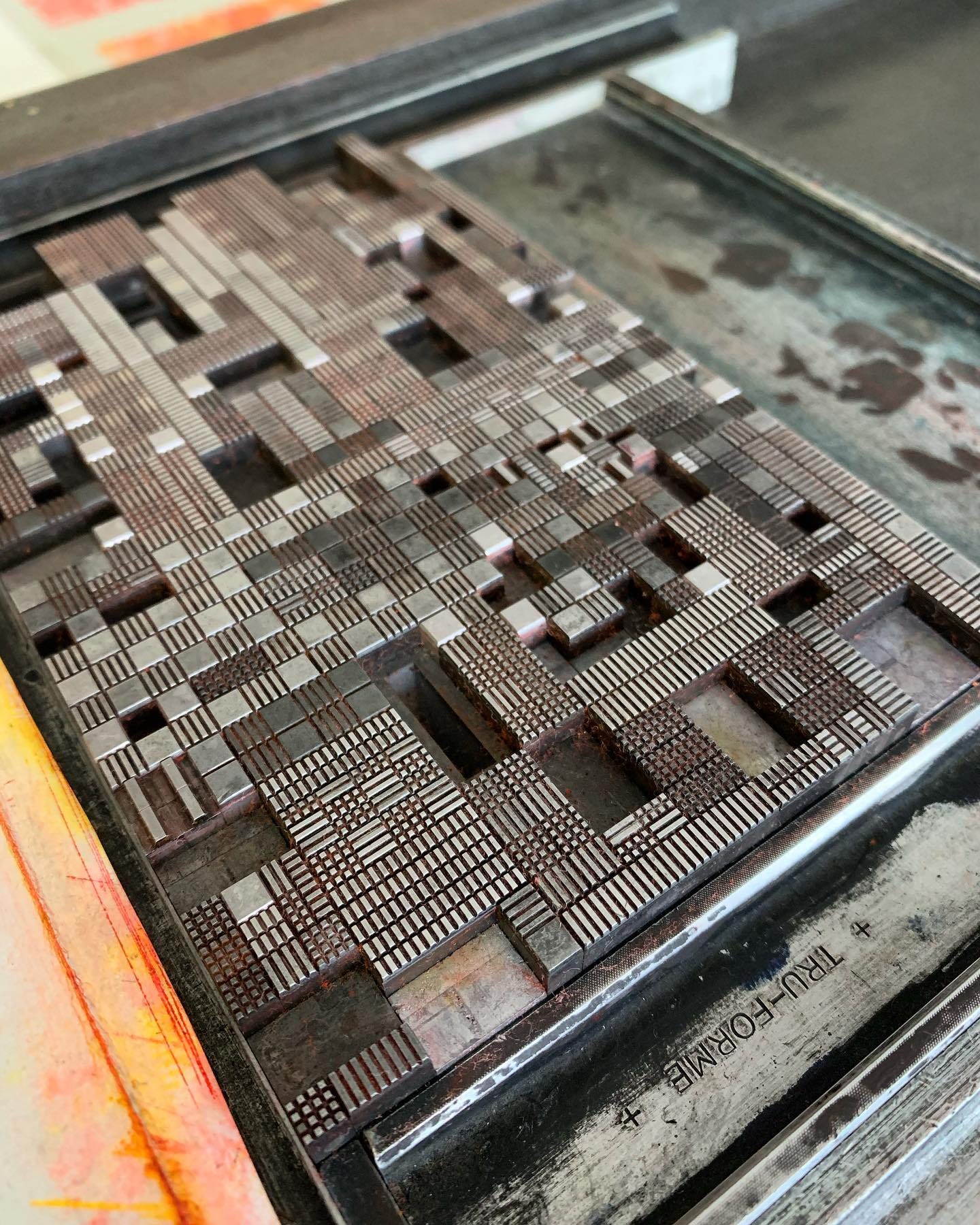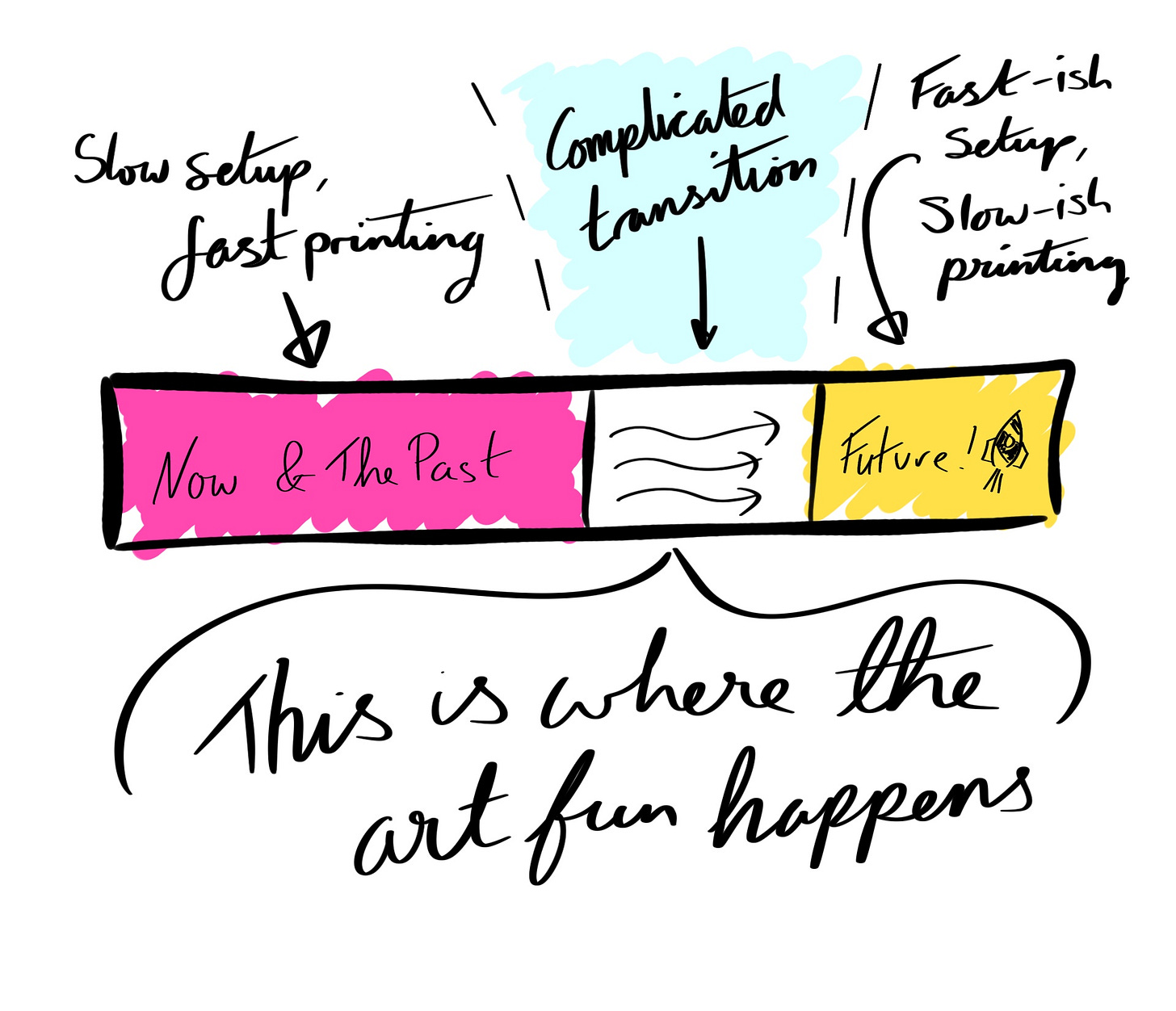📙 #059 - Generative Art & the Printing Process
Exploring the intersection of X and Y
This quote comes from Newspaper Club, around 2009-2010, and I’m guessing Russell wrote it. I could confirm both of those things; date and source, but I don’t want facts to get in the way of a story.
We’ll come back to this quote in a moment.
# Art is where we break the contract of perfect reproduction
I’m fascinated by the inflection point when an artwork or design can be generated from code in less time than it takes to print/plot/produce/perform it.
I had a kinda long winded way of trying to explain that fascination, but I remembered that you’re smart; I can give you the main points and you’ll fill in the gaps better than I’ve been able to. Here we go…
Monks sure took a long time to hand write the bible*; a single painting is a lot of work; hand weaving a large rug takes ages; and they’re all unique one-offs.
Technologies have been invented that strive towards perfect reproduction.
The aim is to recoup the cost of the set-up time by the speed of reproduction.
The most obvious example is the Gutenberg letterpress with it’s moveable type, or newspaper printing plates where a large amount of time, skill and preparation was put into setting things up. But once that was done you could (relatively) quickly produce hundreds of ideally identical prints.
Once an artist has invested all the time into carving a woodblock they can then ink it up and make multiple prints.
Making a screen for screen printing not only involves… insert rest of sentence here, you know the drill.
Industrialisation and the move towards speed took the process even further out of the hands of artists and craftsthem (am I doing that right?**)
So it comes as no surprise that we, us, you, me, now look for ways to subvert industrialised processes to return the hand of the artist to it. Reintroducing the collaboration between human, code and machine.
Or; ‘how can I make each one more “human” without totally giving up the benefit of automation?’
# The position of generative art in the print process
Above, two prints from Dulcie Fulton a.k.a. MostlyFlat
Below, the ornaments used to typeset the different layouts printed over each other in various colours.
On the other hand, if we take generative art (or “algorithmic art”, if we want to reinforce that this isn’t “AI-Art”) sent to a printer — the code that generates an artwork can most likely create a new output/artwork in the time it takes the printer to print the current/previous one.
Normally, if an artist is printing an edition of a print, you set the number of copies to print in whatever software and off the image goes to the printer to be printed X times.
But generative art + code can create and queue up X number of single prints in the roughly the same amount of time, instead of an edition of 50 identical prints, you can have 50 different prints.
This is under the assumption that the code written to create the art can indeed generate new ones in the time it takes to print one.
Which is where my interest in the pen-plotter/drawing-machine comes in, and why it seems to go hand-in-hand with code based art. Because a drawing machine can take several hours to create a single print, your code can take several hours to generate a new artwork to be sent to the machine. Which to be honest is more artist friendly too, your code doesn’t need to be fast and good, just good enough to do what you want.
# Fast/Slow code for slow machines.
I was trying to figure out how to fit Anna Lucia’s current “Oefenstof” exhibition into this narrative:
https://galeriemet.com/exhibitions/anna-lucia-oefenstof
https://annalucia.io/Press_Release_Oefenstof.pdf
…and her WTBS Wearable cap project: https://annalucia.io/wtbs-cap.html
Both exploring algorithms + an embroidery machine, but couldn’t quite make it fit. Not because it doesn’t fit (it does), but because I can’t find the words that make it work, so that’s entirely on me. So once again I’m asking you to do the work for me and fill in the gaps.
Here’s another one I couldn’t fit in, Eno, the documentary film by Gary Hustwit (Hi Gary!)
Here are some of my ill-shaped thoughts in sort of time-line order;
A script is the instructions to recreate a play; telling each person involved the correct chronology for events to happen.
“Transmitting” a whole production (performers, set, props, etc) from one distant location to another is difficult and expensive (ask a touring band). But sending a script so it can be recreated has a much lower bandwidth.
The interesting thing about performances in a theatre is that they’re not perfect reproductions (or re-productions), things can change from day to day.
A celluloid movie can take months (years) to script, shoot, edit, produce and publish, but then near perfect replications of performances can be distributed (physically) around cinemas (record once, show many).
Now we can shoot, edit and display digital films, they can be transmitted to venues quickly, for perfect identical showings.
But as now they’re digital, why can’t they be different each time? Which is what the Eno film above is doing. Because Gary has written a script that recomposes the whole thing before (during?) each showing.
Please pretend there’s a little sidebar here about how the word “script” can and has been used above and the work it’s doing controlling a series of events (and what it’s controlling).
Because I can’t squeeze Anna’s or Gary’s work in beyond the blunt method above, here’s a different thing instead.
When I make a screen for screen printing I can’t change the screen between each print, but what if I could? How would that technology work?
What would a wood block print that reconfigured itself between each inking look like?
Previously if I wanted to make many <identical plastic objects> I could use injection molding. But now I have a 3d printer that sits in my studio — it’s a lot slower, sure, (still faster than hand making them though), but that just means instead of identical objects, I can print things within a series and each one can be a variation because why the hell not?
That’s something I can easily(ish) do now with code that would have been a lot harder to do ten years ago.
Technology changes.
There’s a transition period where we take an old/traditional manufacturing process and work out how to subvert it to create unique artworks.
Some of this has already happened, some is yet to come, and some is happening right now (where “right now” is a span of several years (insert thing about ceramics here)).
Here are some more ornaments from Dulcie.
Just look at how beautifully wonderful that set-up is, how physical and tactile. And if you’re anything like me going “I wonder how we could…”
And to be clear I’m not saying old traditional art is bad, just that I’m guessing the focus of the readers of this newsletter (you), is on exploring the complicated transition part shown in the badly draw diagram above.
We love, adore and acknowledge the traditional, while at the opposite end we’re perhaps not that keen when something becomes too easy, we like the messy what-ifs in the middle.
# We have broken your business and now we want your machines
Perhaps it was Tom who said it.
The idea (which I’m going to pretend I know) behind this statement was directed toward newspaper publishers & printers, who were seeing the sale of physical papers cratering because now (i.e. back then) you could instead get all that factual, unbiased news from the internet 🤔
And because the sales of newspapers (and magazines) were going down, the newspaper presses were no-longer running non-stop, and as anyone who owns a pen plotter, drawing machine, 3d printer, industrial printing press knows, if it’s not doing something then it’s just taking up space.
The “now we want your machines” part comes in because Newspaper Club were proposing that while the presses weren’t printing thousands of newspapers they could, pretty please, print out these 300 “indie” papers instead. One side wants to keep the presses running, the other side wants small press runs 🫶
As some models break down new opportunities rise to fill in the gaps.
Where we are with generative art, where Anna is with her embroiders caps, where ArtBlocks is exploring with their recent physical releases, where the amazing generative artists I see on Instagram are with their posts, where you are with your art & explorations isn’t creating a limited edition of 50 identical prints.
We (sadly) haven’t broken the models of industrialised mass production, but we can come for their machines, what’s the smallest number it can print?
Find a model, break it. Find a machine, reconfigure it and use it.
(Could have been Ben)
# THE END
Social Media Quitting progress; we’ve talked about this before, but I think this is the most quitted I’ve been so far.
Under the guise of; I need to focus on the pen plotting tutorials and even posting on the “nice” social media platforms was taking time away from that, I decided to have a six month break from posting to social media.
While I thought it’d be fun to document how I was feeling about not using social media — by posting a short daily video to Instagram Stories — it quickly became apparent that even just that was a distraction from what I was supposed to be doing (making tutorials).
So that means it’s this newsletter once every other week, the weekly #Weeknotes on YouTube (most recent one here: https://www.youtube.com/watch?v=85UqppwP_nc) and my own website which is constantly in need of an overhaul, that are the main way I’ll be pushing things out into the world. Oh an by post, always 📬
I still visit and chat on Instagram, because I don’t feel like totally cutting myself off from my friends and the world, I’m just not putting time into “creating content” for them. I already feel happier.
The next every-other-week newsletter should be with you on the 1st of May, and I’m guessing will contain; rubber stamps vs handwriting in the drawing machine, zines, #ptpx postcards (again, finally) and possibly something about riso machines, scanners and community.
Love you all
Dan
❤️
* Yes, I know monks didn’t write out whole bibles, mainly focusing on various stories here and there.
** Without getting all Stewart Lee about it and deconstructing this joke/non-joke, or going down the rabbit hole that is Gender-neutral alternative to "craftsmanship"?/Strong community support for a bad answer; why? it’s fair to say that while I generally steer clear of politics (although America WTF), the UK has just passed an extremely shitty judgement wrapped in an “it provides clarity” blanket, so I’m feeling a pretty snippy about it all. As always Trans friends are always welcome here, you’ve already broken one model, please break more.













Just a note that I very much liked the “fill in the blanks” parts of this. There’s something broader to take away from that. That detail and depth has its place but sometimes it’s good to just nudge vaguely in the direction of something and say “you know what I mean right?” and that stray thoughts and half finished sentences can lead someplace interesting at their frayed ends.